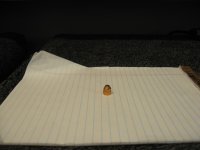A picture of the bullet would go a long way to clearing up the confusion.
There are conical match bullets and SWC match bullets, long nose swc, short nose swcs, all the same weights, jacketed and lead.
MAX COAL .45ACP is 1.275". This is NOT a "load to" length, it's a "do not exceed" length. Slightly shorter is better, less likely to hang up in magazines. standard ball ammo 230gr FMJ is a few thousandths shorter than 1.275"
As you noted, if you load a short 185gr slug to 1.275" there's almost no bullet in the case. Load them shorter, you won't hurt anything. Generally speaking, .45acp SWC bullets should be loaded with the shoulder of the bullet at or just barely above the case mouth. Loaded length will then be what ever it is, 1.235", 1.115", whatever, depending on the nose length of the bullet. As long as they are shorter than max length it should work fine.
Don't worry (too much) about a slightly deeper or different seating depth, (unless working with max loads, and the bullet in question isn't the right one for that, anyway).
The .45ACP is a fairly low pressure round, and much, much more tolerant of a slight change in seating depth than a 9mm or that grenade in waiting .40S&W.
Load them so the "look right" use a moderate charge, and shoot them up. Next time, buy something you definitely know what it is.
And NEVER buy any "reloaded" ammo (especially in bags with no maker's name & address) at a gun show, unless you intend on breaking it down for cases and slugs and tossing the powder. The risk just isn't worth the savings.
Good Luck!
There are conical match bullets and SWC match bullets, long nose swc, short nose swcs, all the same weights, jacketed and lead.
MAX COAL .45ACP is 1.275". This is NOT a "load to" length, it's a "do not exceed" length. Slightly shorter is better, less likely to hang up in magazines. standard ball ammo 230gr FMJ is a few thousandths shorter than 1.275"
As you noted, if you load a short 185gr slug to 1.275" there's almost no bullet in the case. Load them shorter, you won't hurt anything. Generally speaking, .45acp SWC bullets should be loaded with the shoulder of the bullet at or just barely above the case mouth. Loaded length will then be what ever it is, 1.235", 1.115", whatever, depending on the nose length of the bullet. As long as they are shorter than max length it should work fine.
Don't worry (too much) about a slightly deeper or different seating depth, (unless working with max loads, and the bullet in question isn't the right one for that, anyway).
The .45ACP is a fairly low pressure round, and much, much more tolerant of a slight change in seating depth than a 9mm or that grenade in waiting .40S&W.
Load them so the "look right" use a moderate charge, and shoot them up. Next time, buy something you definitely know what it is.
And NEVER buy any "reloaded" ammo (especially in bags with no maker's name & address) at a gun show, unless you intend on breaking it down for cases and slugs and tossing the powder. The risk just isn't worth the savings.
Good Luck!

